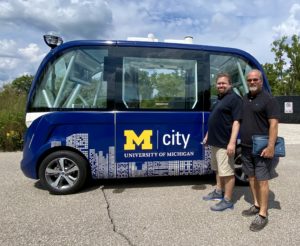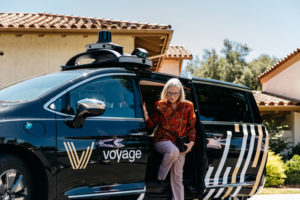
13 Sep Hop inside a self-driving vehicle – Are you ready?
A recent visit to Mcity in Ann Arbor, MI provided deeper insight into autonomous vehicle (AV) technology, its current capabilities, and some of the challenges and hurdles slowing its adoption as a mainstream mode of transportation. In this article, I share observations of our tour, as well as speculate the potential, especially as a transportation solution to serve those with special needs. We’ve captured some of the highlights of that tour in a video conversation as well.
Up until recently, I had no idea this place existed. Upon first learning about it, I knew KEVADVOTECH had to pay a visit. Without a doubt, access to transportation is a key challenge for many in disadvantaged communities, including those with special needs. And we are always on the lookout for emerging technology trends and solutions, and how it can help solve our biggest challenges.
What is Mcity?
Mcity operates the world’s first purpose-built proving ground for testing the performance and safety of connected and automated vehicles and technologies under controlled and realistic conditions. It’s quite an impressive place. Picture it as a small town, complete with streets, intersections, freeway onramps and exits, and railroad crossings; things that compose the infrastructure to support transportation and its community around them.
Mcity is best known as a test track. But that test facility is just one element of the public-private partnership initially known as U-M’s Mobility Transformation Center (MTC). The facility was visionary when it opened in 2015 because there were so many resources being thrown at vehicle technology, but nowhere to really put those vehicles to the test.
You can learn more about it from a January 2022 Q&A with Director, Henry Liu, as he outlines his priorities for Mcity.
Onboard our tour shuttle
 Kevin and I were appreciative of the opportunity to get our very own, personal tour. Upon arrival at the main office, we were greeted warmly by our host, Assistant Director, Vicki Waters. We then boarded a small, automated shuttle bus, which looked like it could seat 8 passengers. Once onboard, we were introduced to John Gagern, the technical engineer that was there to ensure a safe tour experience.
Kevin and I were appreciative of the opportunity to get our very own, personal tour. Upon arrival at the main office, we were greeted warmly by our host, Assistant Director, Vicki Waters. We then boarded a small, automated shuttle bus, which looked like it could seat 8 passengers. Once onboard, we were introduced to John Gagern, the technical engineer that was there to ensure a safe tour experience.
Vicki was extremely gracious as she allowed me to take some videos throughout the tour, as I wanted to capture highlights of our conversation as well as some of the surrounding environment. You can see those highlights here or at the end of the article.
We quickly got a good sense of the layout of the surrounding environment as the shuttle made its way onto the highway portion of the test track. I quickly noticed an exit sign indicating “I-75 North to Flint.” For southeastern Michiganders, that should resonate as a familiar sight along a few well-traveled roads. Along the way, Vicki explained how different features, such as on-ramps help to create scenarios of real-life incidents such as an unexpected cut-off by a merging vehicle.
At one point, the shuttle stopped in the center of town so we could discuss other aspects of the environment, the technology, the supporting infrastructure, and some of the work being done to raise more public awareness toward all the benefits this mode of transportation could provide.
 Vicki could sense that Kevin needed to stretch his legs a bit, so we wandered out of the shuttle and walked, as Vicki demonstrated some of the environmental control features from her mobile phone. At one point, she activated the railroad crossing guard rails and signals to simulate an oncoming train. At Mcity, anything you can simulate and activate from the Control Center can also be controlled through a laptop or mobile phone app they’ve developed for testing purposes.
Vicki could sense that Kevin needed to stretch his legs a bit, so we wandered out of the shuttle and walked, as Vicki demonstrated some of the environmental control features from her mobile phone. At one point, she activated the railroad crossing guard rails and signals to simulate an oncoming train. At Mcity, anything you can simulate and activate from the Control Center can also be controlled through a laptop or mobile phone app they’ve developed for testing purposes.
 We then got a chance to peek inside their garage, which housed a few of the autonomous vehicles, as well as some ‘props’ used for testing. The fake deer in the garage quickly caught our attention. For anyone who has traveled rural country roads in Michigan or other parts of the country, you know how dangerous it can be to experience a deer jumping into the road in front of you. Mcity has thoroughly tested many scenarios like these.
We then got a chance to peek inside their garage, which housed a few of the autonomous vehicles, as well as some ‘props’ used for testing. The fake deer in the garage quickly caught our attention. For anyone who has traveled rural country roads in Michigan or other parts of the country, you know how dangerous it can be to experience a deer jumping into the road in front of you. Mcity has thoroughly tested many scenarios like these.
Our tour was complete at that point, and we settled back into the shuttle and headed back to the main office, where we thanked our wonderful hosts, Vicki and John. It was truly a worthwhile experience, and once again, it filled me with great pride as a UM alum knowing the university continues to show the way through leadership and innovation.
Key Takeaways
 First, I quickly came to appreciate how complex it is to simulate and account for the near countless number of conditions an autonomous vehicle needs to analyze in real time in order to provide a safe experience. This includes the safety of both the passengers and the surrounding participants in its immediate path. Mcity and its partners recognize that safety is top priority; there is no compromise.
First, I quickly came to appreciate how complex it is to simulate and account for the near countless number of conditions an autonomous vehicle needs to analyze in real time in order to provide a safe experience. This includes the safety of both the passengers and the surrounding participants in its immediate path. Mcity and its partners recognize that safety is top priority; there is no compromise.
Secondly, in order to make driverless transportation a reality, there are numerous stakeholders. While the technology often gets the most headlines, bringing this mainstream requires active participation and support of government, including national policy makers as well as local government and community services. This also requires support and input from other industries such as insurance providers, and law professionals. You can learn more about who they are and their level of involvement here.
Public perception is key to acceptance
For driverless vehicles to become mainstream, there needs to be the highest level of trust by the consumer. Trust in that the technology is completely safe, as well as reliable. And even if statistics overwhelmingly suggest the driverless experience will be safe and reliable, it still often boils down to how an individual feels psychologically. Some people are not accepting of change, period. Especially when it pertains to technology and advancement. Even my household is split. I’m “all in” and ready to get Kevin and I in a driverless vehicles asap, but my wife is extremely reluctant. Odds are high she would never try it.
Trust and psychological acceptance are probably the biggest obstacles to clear. In my view, the only way to overcome this is to launch an ‘all out’ public relations campaign to demonstrate its safety, reliability and benefits. But now is not that time to launch such a campaign, not until priorities change. Today, priorities have seemed to shift heavily towards EV (Electric Vehicles). At least for the time being.
AV versus EV – are they somewhat competing agendas?
Accelerating AV adoption will continue to require significant sponsorship and funding from the highest levels (public and private). However, much of the attention, including government policy and funding today seems to have significantly shifted to EV (Electric Vehicles).
 While Autonomous vehicles (AV) are often inextricably linked with Electric vehicles (EV), there are key differences to consider. While AV is based on mostly electric and to a lesser extent, hybrid powertrains, infrastructure needs can differ. I think of AV’s being a potentially better option for ridesharing, mass transit, or taxi service (i.e Uber). This would require charging stations to be housed on a bigger footprint, perhaps enough stations to accommodate dozens (or even hundreds) of vehicles at one time, all in a centralized location.
While Autonomous vehicles (AV) are often inextricably linked with Electric vehicles (EV), there are key differences to consider. While AV is based on mostly electric and to a lesser extent, hybrid powertrains, infrastructure needs can differ. I think of AV’s being a potentially better option for ridesharing, mass transit, or taxi service (i.e Uber). This would require charging stations to be housed on a bigger footprint, perhaps enough stations to accommodate dozens (or even hundreds) of vehicles at one time, all in a centralized location.
For EVs, the typical single-family driver would seek charging stations that might be scattered in much lesser quantities but in multiple locations throughout a city. We continue to see charging stations more and more in parking garages, for example.
Some argue that primary use cases of AV, such as taxi drop-offs could create more traffic congestion. In theory, an AV might not require a parking spot when dropping someone off for a brief appointment. They might simply continue to drive the nearby streets while waiting, potentially creating unnecessary traffic. I’m not sure this is a reasonable assumption or even a possibility, but it is clear all sides of this coin need to be continually examined and accounted for.
But once most of the issues (including cost and affordability) are resolved during this period of heavy emphasis on EVs, AV adoption could quickly follow. It seems like a natural progression
Is there an immediate opportunity for driverless vehicles?
Absolutely. Many would agree the best places to implement driverless technology and transportation today is in larger scale, retirement communities. There are several reasons. First, many of these communities are somewhat self-contained, meaning, the local consumer’s destination, whether it is for a doctor visit, a restaurant, grocery shopping or a golf course, most are within a short distance and without need to leave the community proper.
From a technical aspect, the operational domain is more manageable.
And one obvious reason AV as a primary mode of transport could work is simply based on the fact our driving skills do decline as we age, as difficult as that is to sometimes admit. I’m in my 60’s and realize that topic looms somewhere down the line. No offense intended to any senior citizen behind the wheel of a car, but there comes a point where driving becomes difficult and eventually not wise. Driverless vehicles could make perfect sense for this type of community.
 In fact, research and testing was done a few years ago in The Villages, FL by Voyage. The Villages is the largest planned retirement community in the world. With a +55 population well over 100,000 today (and growing double digits), the environment lends itself to AV transportation. Ruth, Kevin and I have enjoyed The Villages as our 2nd home nearly four years now and hope to eventually live there fulltime. I can attest firsthand that AV transportation would be a good fit, provided psychological acceptance by the local population, of course.
In fact, research and testing was done a few years ago in The Villages, FL by Voyage. The Villages is the largest planned retirement community in the world. With a +55 population well over 100,000 today (and growing double digits), the environment lends itself to AV transportation. Ruth, Kevin and I have enjoyed The Villages as our 2nd home nearly four years now and hope to eventually live there fulltime. I can attest firsthand that AV transportation would be a good fit, provided psychological acceptance by the local population, of course.
In addition, driverless vehicles could be the answer for our special needs families within The Villages. There are at least 300 families in similar situations as us (a special needs adult child living with their parents). We’re hoping to get a special needs housing facility built within the next 3-5 years that will house at least 100 residents. Some may choose to remain in their parent’s homes when they pass on. In either case, automated transportation could make sense for this large and growing community.
In addition, companies like May Mobility have already deployed driverless technology for use in a few communities, including Ann arbor, the home of Mcity and The University of Michigan. Although routes and operating times are currently hardwired (limited), they continue to prove the concept is a viable solution. And by the way, a ride is free of charge!
Ongoing benefits of all this research and testing
Overall, we as consumers will continue to benefit, even if driverless vehicles are not on the near horizon as a primary means of transit. Today’s vehicles are loaded with this AV technology, all intended to improve our lives and provide personal safety. Cameras, sensors, and other key electronic components continue to quickly evolve and improve, all while making our driver experience more pleasurable and safer. None of these improvements would have been possible without the vision of autonomous vehicle related companies as they continue to explore the art of the possible.
While none of us can yet predict when AV will become prevalent in our society, I’m thankful that organizations like Mcity and their partners continue to invest and advance these technological capabilities. We’ll continue to follow this developing story at KEVADVOTECH.


